Concierge vs. Triage – Evaluating Cost-Effectiveness and Patient Outcomes in Emergency Care
A ‘concierge’ treatment sounds like a plausible way of managing patients within a healthcare center. However, how would this be different from the triage already present in every ED? I think it is a replication of services which would mean more staff being employed, which may increase costs. The concept could work where a health facility does not experience large traffic but where emergencies and high-traffic days (such as the weekends) are the order of the day, liaising with other specialty centers would be more impactful. In the article you mentioned, the researchers aimed to evaluate whether the management of patients with hematological malignancies who are susceptible to life-threatening infections after chemotherapy could be done in dedicated inpatient and emergency wards and if this would provide superior infection prevention and outcome. The results of their study showed that an accuracy that was high for the proposed mortality and infection risk-prediction models. The results also demonstrated the feasibility of the temporal assessment of patient risks which could enable physicians to move from one-point decision-making to a continuous dynamic observation that would allow for an admission policy that was more flexible and patient-tailored (Carmen et al., 2019). In this case, where it is a specific group of patients, then the model would work but at additional costs. If the unit is created to hopefully reduce congestion at the ED, then as I mentioned, I believe, it would not work in a profitable way. To contain costs and reduce reimbursements, coordination of an acute care setting, local primary care providers, and community agencies would be the best way to go. This will ensure patients are attended to faster. The treatment costs will be lower, and the outcomes will be far better, while the market share for the different health conditions will be enhanced significantly (Porter & Lee, 2013).
References
Carmen, R., Yom-Tov, G. B., Van Nieuwenhuyse, I., Foubert, B., &Ofran, Y. (2019). The role of specialized hospital units in infection and mortality risk reduction among patients with hematological cancers. PLoS ONE, 14(3), 1–17. https://search-ebscohost-com.ezproxy.ccu.edu/login.aspx?direct=true&db=aph&AN=135634256&site=ehost-live
Porter, M & Lee, T.H. (2013). The strategy that will fix healthcare. https://hbr.org/2013/10/the-strategy-that-will-fix-health-care
ORDER A PLAGIARISM-FREE PAPER HERE
We’ll write everything from scratch
Question

Concierge vs. Triage
For people to enjoy health at the optimal level, either as individuals or as a community, then, they must be beneficiaries of excellent healthcare services. These services must also be well coordinated within a robust public health system. The different players in the healthcare sector usually encounter minimal interaction, systems planning, collaboration, and communication among these entities is almost incidental and limited to their operations (Nellans & Waljee, 2014). When a community has a communication channel that enables frequent feedback and information flow among the different stakeholders (acute care settings, local primary care providers, and community agencies), then the goal of improving value for the patients will be achieved where value will be defined as the outcomes of health which are delivered and matter to patients in relations to the cost of producing the outcomes. Because of the pressure to contain costs, players aim at reducing reimbursements and eventually move away toward performance-based from fee-for-service reimbursement. The treatment of patients will be faster, the prices will be lower, the outcomes will be better, and the market share for different health conditions will improve. Rather than having all persons visiting the same healthcare facility, patients with specific conditions will be referred to specialized facilities following open communication; this will leave the general hospital free to cater to the more common and not-so-severe illnesses. This will reduce waiting time, and improve efficiency and costs. Different groups of patients require different care locations. They also need services that take a head-on approach to the crucial role of preventive care and lifestyle change in costs and outcomes, and the services also need to be tailored to the overall circumstances of the patients. When communication is open between the service teams, and the appropriate clinical team, education, and preventive services can be put in place, eventually improving value with measurable results. This will mean that not-for-profit hospitals may have fewer persons seeking services (Porter & Lee, 2013). Patients will find the impetus to seek insurance at a low cost and visit specific healthcare facilities in the community that will cater to their needs.
God Bless
Lisa
References
Nellans, K., & Waljee, J. F. (2014). Health Services Research: Evolution and Applications. Hand Clinics, 30(3), 259-268.
Porter, M & Lee, T.H. (2013). The strategy that will fix healthcare. https://hbr.org/2013/10/the-strategy-that-will-fix-health-care
RE: Community Health
Top of Form
Hi Lisa,
I like how you pointed out how a communication channel would improve value for the patients. Your point on how patients will be able to be referred to specialized facilities is interesting. This could end up saving a patient’s life, because it may prevent the patient from being misdiagnosed. However, one article I read mentioned that a small emergency department “may provide a ‘concierge’ treatment with faster reach of the required specialist” (Carmen 2019). For this reason, I think that a hospital should still be trained to be able to treat any case that may arise, and not just be prepared to send the patient somewhere else. What is your stance on this subject?
Reference:
Carmen, R., Yom-Tov, G. B., Van Nieuwenhuyse, I., Foubert, B., & Ofran, Y. (2019). The role of specialized hospital units in infection and mortality risk reduction among patients with hematological cancers. PLoS ONE, 14(3), 1–17. https://search-ebscohost-com.ezproxy.ccu.edu/login.aspx?direct=true&db=aph&AN=135634256&site=ehost-live

